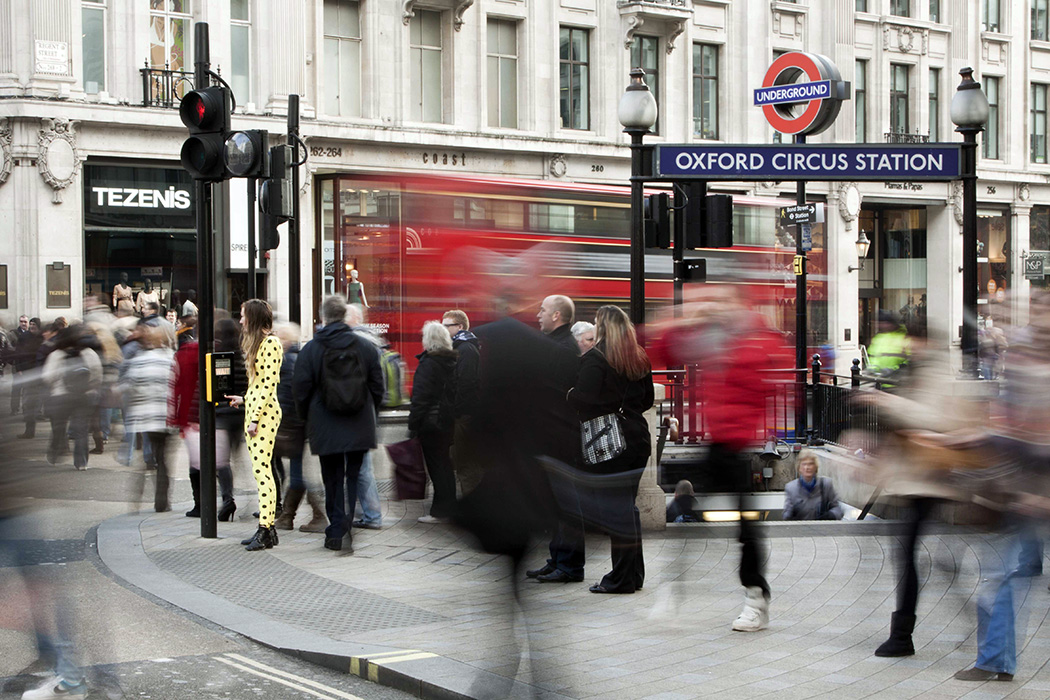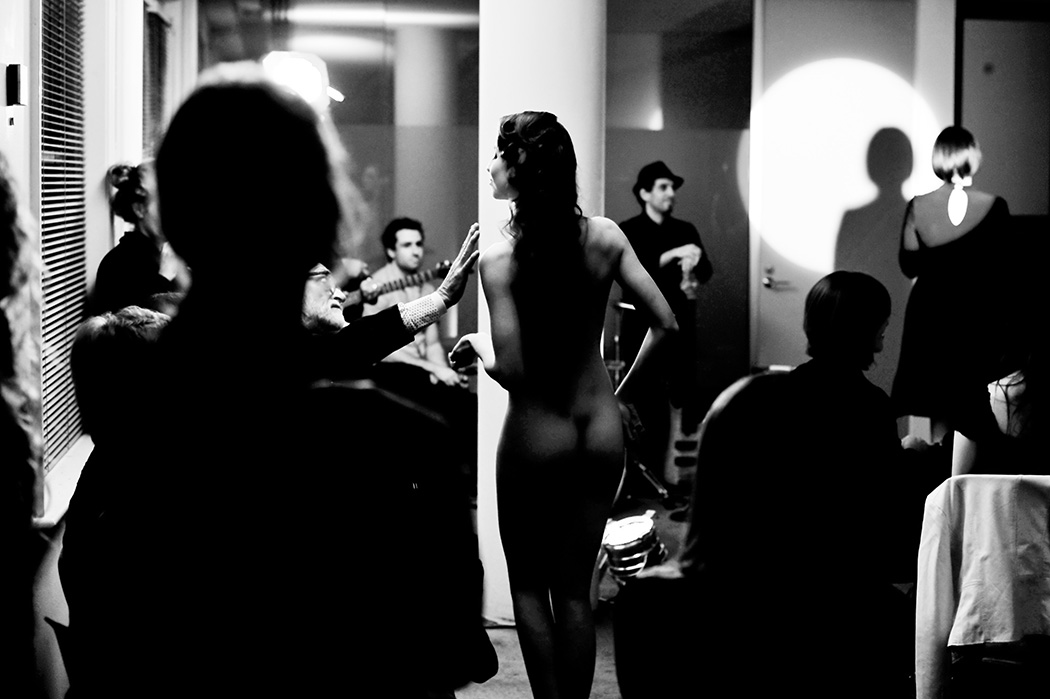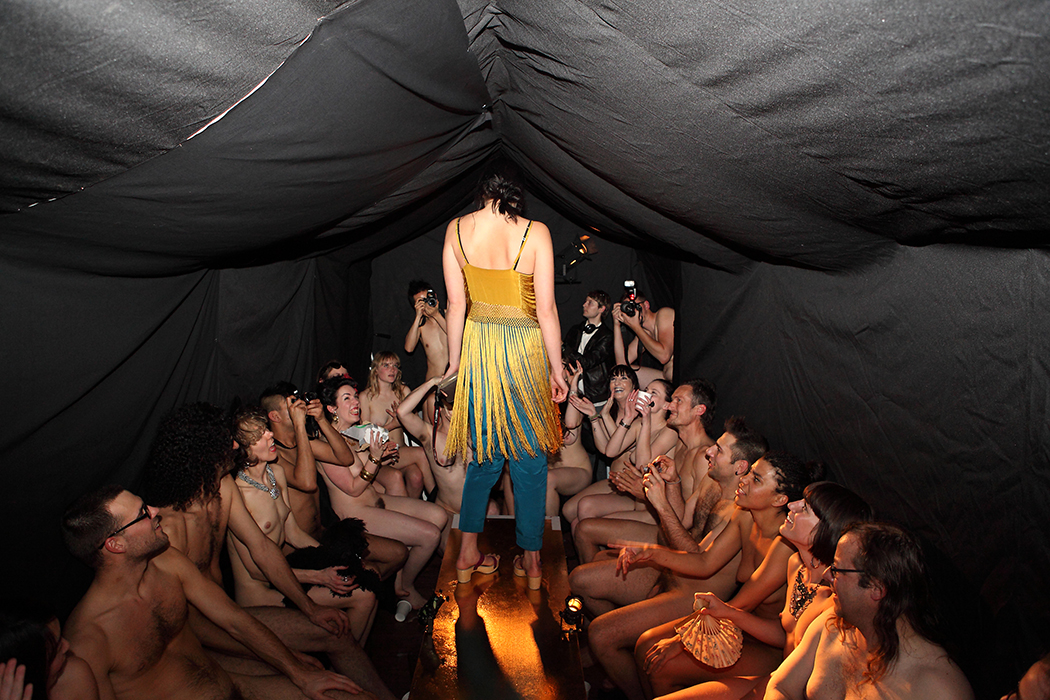Adele Varcoe is an Australian fashion practitioner whose work explores notions of dress and undress. While perhaps best known for her performance happenings such as iFold: say ‘hello’ to a new you (Melbourne, 2011) and Imagining Chanel (London & Sydney, 2012 and Melbourne, 2014), her work has also been instrumental in outlining new methodologies in fashion research. Following Varcoe’s threeweek residency at ArtEZ Institute of the Arts in Arnhem, Netherlands, Address contributor Megan Wray Schertler sat down with Varcoe to discuss her experiences as a student of fashion and why she wants your wardrobe.

Source: Adele Varcoe
Megan Wray Schertler: The way in which your body of work dances between performance art and fashion makes it difficult to pin down to one specific category. Whether it is fashion or performance or art, what I find most interesting is that you are approaching all of these disciplines through the lens of a researcher. You are currently working on your doctoral research and, on many levels, your research methodology and use of these less conventional research mediums really challenges what it means to be a fashion academic today. Could you begin by talking a bit about the ideas you were focusing on earlier in your studies and how they grew into the larger questions your work deals with today?
Adele Varcoe: Well, during my Bachelor’s degree, I guess I was interested in eliminating processes within fashion design. I was questioning fashion or what a fashion practitioner does, without really consciously asking myself these questions. The first and second year are focused on learning all the technical things, tools I guess, that you need to understand clothes and make clothes. I think it was in third year when I decided that I was going to eliminate pattern making from my process. I thought, ok, how would I go about making clothes if I just eliminated pattern making? So I ended up drawing shapes directly onto cloth and then cut and sewed. And then the next semester I decided I was going to eliminate mannequins. And then I eliminated sewing. It was then that I started exploring other materials like latex and silicon and other ways that you could kind of put cloth together with glue and all sorts of different things.
I was also making these little stories as well – I made these claymations about clothes having a life of their own or the relationship between people and their clothes. A lot of them focused on how clothes spend a lot of their time on the floor, in the cupboard or in drawers and what happens to clothes when people are outside. You might buy something and you might only ever wear it once and what sort of life that is for the clothes? I was interested in this idea that clothes have a life of their own and giving power to them in some way. Then it moved on to the idea of clothes being underneath the skin, about being part of our bodies. I started working with the silicon that I had been exploring to stick cloth together to create these garment shape type things. I would make casts of clothes from my wardrobe, like in moulds, then I would pour silicon into them so it looked very skin like and then photograph that on top of the body. The idea was that it was the impression of the clothes underneath the skin, of the merging of the clothes and the body.
So from all of this silicon exploration, I really wanted to continue working with these materials. I ended up interning with Bernhard Willhelm for a few months in Paris. There I was doing more set design projects. I did a few prototypes on the sewing machine but because I had been breaking a way from fashion construction he really asked me to do more sets for their shows and showrooms and painting their bodies for photo shoots. It was more like art direction type stuff that I was involved in.
MWS: While Bernhard Willhelm is certainly not known as a conventional fashion designer, his work still exists in the realm of the fashion system. After having moved away from fashion design, what drew you to want to do an internship in a fashion studio? How was it that you connected with Bernhard?
AV: He was in Melbourne in 2004 and one of my tutors, I think I was in fourth year at the time, said that I should show my work to him. So I did and we just started this dialog that we kept up for a few months. It just sort of happened that way. By the time I finished my fourth year of the Bachelor’s, I had spent that time with Bernhard and broken away from these processes. After graduation, I was doing more set design type things and working with the silicon, so I transitioned and went into film doing prosthetics, body parts and masks, for Australian films. That was really cool. I realised then that there was something in the last part of my fourth year that I really wanted to explore further, this idea of the merging and clothing and the body. I thought that doing a Masters would give me time to really push the ideas further. I just felt like an interesting moment had happened and I really wanted to see where it could go. I set out with simple questions in my Masters. One was: what are clothes? And the other one was: what does it mean to feel dressed? I explored those questions with silicon and latex, lipstick, all sorts of things, and put them all on to my own body in this tent that I had pitched up in the back yard.

Imagining Chanel, A Salon Fashion Show; The Fashion Space Gallery, London 2012; The Rocks, Sydney 2012; MUMA, Melbourne 2014; Source: Adele Varcoe / Dave Stefanoff
MWS: I noticed that the tent seems to be a recurring thing in your work. It literally keeps popping up.
AV: I like that you picked up on that. I really just buried myself in this tent and would do all these wild experiments. I was thinking a lot about, what are clothes? If clothes are made in different material are they still clothes? I was challenging what the definition of a garment is. What is it that defines a garment? Is it a shape? Is it the material it’s made from? Is it a perception or the way that it feels when you put it on, the way you put it on, or the engagement between the body and the garment? This lead me to start working directly with the skin as a material; pleating and folding and tucking it. I was working with it as you would work with fabric on a stand. It began with my body, then moved on to my partner at the time’s body and then friends started volunteering their bodies. It ended up being this big material investigation into skin and how subtle modifications in the skin can create the sensations of feeling dressed or naked. So it was questioning dress, really.
At that stage, I was practicing this skin folding technique in the privacy of people’s homes. I had the idea that skin folding could be this hot new trend or a new way of dressing. I really wanted this to be perceived as something that was fashion, something that was dress. Thinking about what makes us feel dressed, it can be a sensation but it is also the way that the people around us respond to how we’re dressed that makes us feel something. I thought about how you could create an environment where people would feel comfortable going out and would feel dressed in their skin folding. I guess that’s where fashion came into it, how fashion manipulates our perception of dress and what are the tools involved in doing that. For example, putting skin folding into a fashion magazine and distributing copies of it.
MWS: I’m interested in the ethical boundaries involved in your work as an academic practitioner since you used other human bodies as a research tool. Did you come up against any opposition to your research from the university or review boards?
AV: Ethics has become a much more present thing in the university; I think back then it was really a grey area in art and design. Half way through the skin folding skin-folding project, I presented the work at a conference and a women from the States asked if I had ethics approval. It kind of blew up into this big thing then. Luckily, I could already see where the project was going at the point and was able to outline the project clearly for ethics approval, so it was all ok in the end. I am finding it really challenging, though, with ethics approval in my doctoral research. I guess it’s the way I’ve been working. I don’t usually say, ‘ok, this is my method and these are the projects’. Things unfold while working on each performance. So much of it is feeling what you feel at that moment when things happen and how people respond. It’s hard to calculate what is going to happen and what that can lead to. For me, it’s the unexpected things that happen that I find really exciting and want to explore further. I think it’s boring if you can already predict what’s going to happen. It doesn’t motivate me to do it.
MWS: Do you find that the discussion of what is ethical or unethical around your work has made you think about your work differently than if you were an independent practitioner outside of the university?
AV: I think it’s more the interrogation. It pushes you to really think, ‘ok, what is it I am trying to say here?’. What am I trying to do? What is this saying about fashion as a discipline in itself? I’m quite strong about saying that I’m a fashion practitioner. I’m fine with the label of ‘artist’ as well, but I think it’s really important for this work to sit within a fashion context. I’m all for expanding the field of fashion and revealing other ways that fashion can be expressed. A fashion practitioner today can be so many different things. The way we experience fashion is something beyond clothes; all the things surrounding clothes are just as important as the clothes themselves.

Newfangled, Participatory Catwalk Fashion Show; Craft Victoria, Melbourne 2011; Source: Adele Varcoe / Pete Waters
MWS: Something that is also a big part of your work is your personal wardrobe of jumpsuits and the fact that they are all you wear. What started as your performance-of-sorts exploring how what we wear shapes our identity has now been going on for three years. You can be immediately identified by the jumpsuit. But then in doing research for this interview, I began to come across images of pre-jumpsuit Adele – images where you’re wearing just jeans and a sweatshirt. I was fascinated by how shocking I found these images to be. It felt like I had not discovered a different version of you but a different person entirely. Your relationship with the jumpsuit now, is it still an object that you feel you’re testing or do you feel like it’s been absorbed into your identity to the point where it is invisible to you after three years of wearing it?
AV: It’s really funny you should bring this up because I’ve just posted an ad to try and find someone to swap wardrobes with for a month in order to step outside of the jumpsuit. It has been three years and I feel quite comfortable in it. It has become an identity. It has been really interesting in terms of identity and, like you said, when you see me outside of the jumpsuit it’s really bizarre. I think it’s really interesting how clothes play this role in how we’re perceived and how people think of us.
MWS: Three years is a long time. That’s over 1000 days of testing this idea, exploring how people relate to you in this suit.
AV: I’m struggling now with what else to wear and what to do about it. Everyday I get up and I just pick a colour. It’s become the everyday. So that’s why I’m looking for someone to swap wardrobes with. I want to feel someone else’s experience now and for someone else to experience the jumpsuit, and document that. I’m interested in exploring just wearing someone else’s wardrobe, too. It’s a play on identity. So I’m ready to step outside of it and I’m looking for that person who’s open and up for it.
MWS: I hadn’t thought about it, the idea of moving past it, but going back to participating in accepted social codes of dress becomes this really overwhelming task after having existed outside of them for such a long time. Even the cut of a trouser could define post-jumpsuit Adele as more masculine or feminine, etc. To actively purchase clothes becomes a really intense experience. I guess swapping rectifies the situation or allows for an easier transition.
AV: Yes, and letting go of the control of what I wear. Part of me now just wants to see what happens if other people select things for me. I think that is part of the wardrobe swap, too, like I’m not actively choosing these things for me. I guess fashion today does that already in a way, like the fabric for the jumpsuits are something I choose and it’s dictated by what is available in the store. I just don’t feel comfortable going shopping now.
Megan Wray Schertler
Megan is the founding editor of Varsity, fashion’s first collections magazine solely dedicated to London’s emerging talent. Originally from New York, she recently relocated to the Netherlands to undertake postgraduate work in Fashion Strategy at ArtEZ Institute of the Arts.

